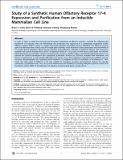Study of a Synthetic Human Olfactory Receptor 17-4: Expression and Purification from an Inducible Mammalian Cell Line
Author(s)
Zhang, Shuguang; Chung, Hyeyoun; Ernberg, Karin E.; Cook, Brian L.
DownloadCook-2008-Study of a Synthetic.pdf (424.2Kb)
PUBLISHER_POLICY
Publisher Policy
Article is made available in accordance with the publisher's policy and may be subject to US copyright law. Please refer to the publisher's site for terms of use.
Terms of use
Metadata
Show full item recordAbstract
In order to begin to study the structural and functional mechanisms of olfactory receptors, methods for milligram-scale purification are required. Here we demonstrate the production and expression of a synthetically engineered human olfactory receptor hOR17-4 gene in a stable tetracycline-inducible mammalian cell line (HEK293S). The olfactory receptor gene was fabricated from scratch using PCR-based gene-assembly, which facilitated codon optimization and attachment of a 9-residue bovine rhodopsin affinity tag for detection and purification. Induction of adherent cultures with tetracycline together with sodium butyrate led to hOR17-4 expression levels of ~30 µg per 150 mm tissue culture plate. Fos-choline-based detergents proved highly capable of extracting the receptors, and fos-choline-14 (N-tetradecylphosphocholine) was selected for optimal solubilization and subsequent purification. Analysis by SDS-PAGE revealed both monomeric and dimeric receptor forms, as well as higher MW oligomeric species. A two-step purification method of immunoaffinity and size exclusion chromatography was optimized which enabled 0.13 milligrams of hOR17-4 monomer to be obtained at >90% purity. This high purity of hOR17-4 is not only suitable for secondary structural and functional analyses but also for subsequent crystallization trials. Thus, this system demonstrates the feasibility of purifying milligram quantities of the GPCR membrane protein hOR17-4 for fabrication of olfactory receptor-based bionic sensing device.
Date issued
2008-08Department
Massachusetts Institute of Technology. Center for Biomedical Engineering; Massachusetts Institute of Technology. Department of Biological EngineeringJournal
PLoS ONE
Publisher
Public Library of Science
Citation
Cook BL, Ernberg KE, Chung H, Zhang S (2008) Study of a Synthetic Human Olfactory Receptor 17-4: Expression and Purification from an Inducible Mammalian Cell Line. PLoS ONE 3(8): e2920. doi:10.1371/journal.pone.0002920
Version: Final published version
ISSN
1932-6203